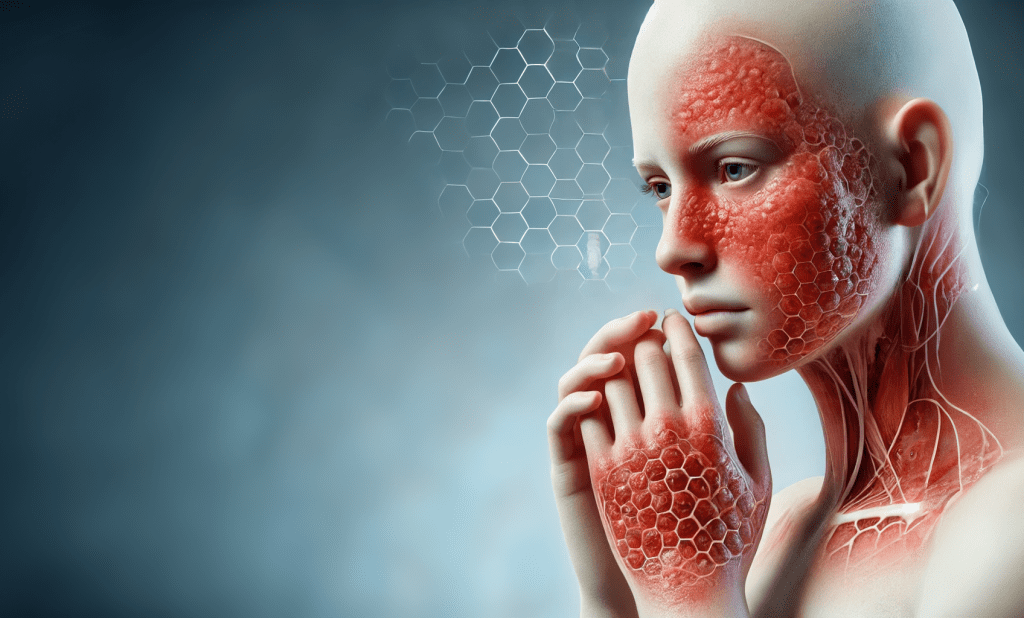Understanding Angioedema: Causes, Symptoms, and Treatment
Angioedema is a condition characterized by the swelling of the deeper layers of the skin due to fluid build-up. It often affects areas such as the eyes, lips, genitals, hands, and feet and may occur alongside urticaria (hives), a raised, red, and itchy rash on the skin.
Symptoms of Angioedema
Angioedema can lead to swelling in any part of the body, but it most commonly affects:
- Eyes
- Lips
- Genitals
- Hands
- Feet
Many individuals also experience hives, which appear as raised, itchy, red rashes on the skin.

Causes of Angioedema
The cause of angioedema depends on the specific type you have. There are four main types:
1. Allergic Angioedema
This type is triggered by an allergic reaction, such as exposure to peanuts or other allergens. It may occur alongside anaphylaxis in severe cases.
2. Idiopathic Angioedema
In this type, the cause of swelling is unknown. However, certain triggers such as stress or infections may play a role.
3. Drug-Induced Angioedema
This occurs as a side effect of medications, most commonly angiotensin-converting enzyme (ACE) inhibitors used for treating high blood pressure and heart conditions.
4. Hereditary Angioedema
This rare form is caused by faulty genes inherited from parents, leading to recurrent swelling episodes. It affects 1 in 10,000 to 1 in 50,000 people worldwide.
Learn more about the causes of angioedema.
Who is Affected?
Angioedema is relatively common, affecting about 10-20% of people at some point in their lives. However, certain forms, like hereditary angioedema, are much rarer.
Diagnosing Angioedema
Diagnosis usually involves a physical examination of the affected skin and a discussion of symptoms with your doctor. Additional tests, such as blood tests or allergy tests, may be necessary to determine the specific type of angioedema. Idiopathic angioedema is diagnosed when no clear cause is found.
Read more about diagnosing angioedema.
Treatment Options for Angioedema
While many cases resolve on their own within a few days, treatment is often used to relieve symptoms, especially in allergic or idiopathic cases.
1. Medications for Allergic and Idiopathic Angioedema
- Antihistamines: Reduce swelling and alleviate symptoms.
- Oral Steroids: Steroid tablets can also help control inflammation and swelling.
2. Treating Drug-Induced Angioedema
Switching to an alternative medication can often resolve drug-induced angioedema.
3. Managing Hereditary Angioedema
While there is no cure, regular drug treatments can prevent attacks in people with hereditary angioedema.
Learn more about treating angioedema and available management strategies.
Symptoms of Angioedema: Signs and When to Seek Help
Angioedema is characterized by swelling that develops beneath the surface of the skin due to fluid accumulation. The condition can present a range of symptoms, which may vary in severity and duration.
Main Symptom: Swollen Skin
- Cause: Swelling occurs due to a build-up of fluid in the deeper layers of the skin.
- Commonly Affected Areas:
- Hands
- Feet
- Eyes
- Lips
- Genitals
- Onset and Duration: Swelling often appears suddenly and may last for 1 to 3 days. A prickling sensation might precede the visible swelling.
- Appearance: The swollen areas are typically not itchy, and the skin may appear normal in color. However, many people with allergic or idiopathic angioedema may also develop urticaria (hives), characterized by red, itchy patches on the skin.

Severe Cases
In more severe cases, angioedema can affect internal areas, such as:
- Throat and Windpipe: Swelling can cause difficulty breathing.
- Bowel Lining: Swelling of the bowel lining can lead to stomach pain, nausea, vomiting, and diarrhea.
Other Symptoms of Angioedema
In addition to visible swelling, angioedema may cause:
- Hot or Painful Sensation: Affected areas may feel hot or painful.
- Throat and Tongue Swelling: This can make breathing difficult and is a serious symptom requiring immediate attention.
- Swelling of the Conjunctiva: The transparent layer covering the white part of the eye, which may affect vision.
Symptoms in Hereditary Angioedema
People with hereditary angioedema may experience:
- Abdominal Pain: Swelling in the stomach and bowel, leading to nausea, vomiting, and diarrhea.
- Bladder or Urethra Swelling: This can cause bladder issues and make it difficult to pass urine.
When to Seek Medical Advice
- Contact Your GP: If you experience an episode of angioedema that does not impact your breathing and you have not been previously diagnosed. Tests may be needed to determine the type of angioedema.
When to Seek Emergency Medical Advice
- Dial 999: If you suspect anaphylaxis, a severe allergic reaction, and inform the operator.
- Symptoms of Anaphylaxis:
- Chest Tightness: Leading to breathing difficulties.
- Swelling of the Tongue and Throat.
- Adrenaline Auto-Injector: If available, use an auto-injector pen while waiting for emergency services.
Causes of Angioedema: Understanding Triggers and Types
Angioedema is often linked to issues with the immune system, but in many cases, the cause remains unknown. Here’s a detailed look at the various causes and triggers associated with different types of angioedema.
1. Allergic Angioedema
This form occurs when the immune system mistakenly reacts to harmless substances in the blood, leading to the release of histamine. This chemical causes blood vessels to expand, resulting in skin swelling.
Common Triggers for Allergic Angioedema:
- Certain Foods: Nuts, shellfish, milk, and eggs
- Medications: Penicillin, aspirin, and non-steroidal anti-inflammatory drugs (NSAIDs) like ibuprofen
- Insect Bites or Stings: Particularly wasp and bee stings
- Latex: Found in medical gloves, balloons, and condoms
2. Idiopathic Angioedema
When no identifiable cause is found, it is classified as idiopathic angioedema. While the exact reason remains unclear, it may involve the immune system “misfiring.” Certain triggers can cause swelling episodes, including:
- Stress or Anxiety
- Minor Infections
- Temperature Extremes: Hot or cold weather
- Exercise
3. Drug-Induced Angioedema
Certain medications can trigger angioedema, with angiotensin-converting enzyme (ACE) inhibitors used to treat high blood pressure being the most common culprits. About 1-5% of people taking ACE inhibitors experience this side effect, with a higher risk among Black individuals.
Other Medications That May Cause Drug-Induced Angioedema:
- Bupropion: Used for smoking cessation
- Vaccines
- Selective Serotonin Reuptake Inhibitors (SSRIs): Antidepressants
- COX-II Inhibitors: Painkillers for chronic pain and arthritis
- NSAIDs: Such as aspirin and ibuprofen
- Angiotensin-2 Receptor Antagonists: Another blood pressure medication
- Statins: Used for high cholesterol
- Proton Pump Inhibitors (PPIs): Treat stomach ulcers
Note: Drug-induced angioedema often develops within the first month of taking an ACE inhibitor but can also occur months or years later.
4. Hereditary Angioedema
This rare form is caused by a genetic mutation in the C1 esterase inhibitor (C1-inh) gene, resulting in a deficiency of C1-inh protein. This protein helps regulate the immune system, and without enough, the immune system can overreact and cause angioedema symptoms.
Triggers for Hereditary Angioedema:
- Trauma or Surgery
- Oral Contraceptive Pill
- Pregnancy
Inheritance: The mutated C1-inh gene is passed through families, with a 50% chance of inheritance by children of affected individuals.
Understanding the specific cause and type of angioedema is crucial for effective treatment and management. Identifying triggers and working with healthcare professionals can help minimize episodes and improve quality of life.
Diagnosing Angioedema: Tests and Evaluations
Angioedema is typically diagnosed through a physical examination of the affected skin and a discussion of your symptoms with a doctor. Identifying the exact cause can be challenging, as there is no single definitive test for angioedema. If a specific cause is suspected, allergy or blood tests may be recommended.
Diagnosing Different Types of Angioedema
1. Allergic Angioedema
Diagnosis focuses on identifying potential allergens:
- Exposure History: Your doctor may ask if you have been exposed to substances known to cause allergies, such as nuts or latex. A history of allergic conditions like urticaria (hives) or asthma will also be considered, as allergic conditions often occur together.
- Medication Review: Inform your doctor of all medications you are taking, including over-the-counter drugs, herbal supplements, and vitamins.
- Diary Tracking: You may be asked to keep a diary of possible irritants, such as foods or environmental triggers, to help identify the cause.
If allergic angioedema is suspected, you may be referred to a specialist allergy or immunology clinic for further testing, which could include:
- Skin Prick Test: A small amount of a suspected allergen is pricked onto the skin to see if there is a reaction.
- Blood Test: A sample of your blood is tested to determine if your immune system responds to a specific allergen.
Learn more about diagnosing allergies.
2. Drug-Induced Angioedema
If you are taking a medication known to cause angioedema, your doctor may stop or replace it with an alternative. Do not stop taking any prescribed medication without medical advice.
- Diagnosis Confirmation: If symptoms resolve after discontinuing the suspected medication, a diagnosis of drug-induced angioedema is likely.
3. Hereditary Angioedema
This form can be diagnosed through blood tests that measure the levels of proteins regulated by the C1-inh gene. Low levels of these proteins indicate hereditary angioedema.
- Specialist Care: Diagnosis and management should be conducted in a specialist immunology clinic due to the complexity of this condition.
4. Idiopathic Angioedema
This type is diagnosed through a “diagnosis of exclusion,” meaning it is confirmed only after all other possible causes have been ruled out through various tests.
- Additional Testing: Your doctor may perform simple blood tests to check for associated conditions such as iron deficiency, liver diseases, or thyroid problems.
Treating Angioedema: Medications and Management Strategies
Treatment for angioedema typically involves medications, although many cases resolve on their own within a few days. The approach to treatment depends on the type of angioedema and its underlying cause.
General Treatments for Allergic and Idiopathic Angioedema
For allergic and idiopathic angioedema, treatment often involves:
1. Antihistamines
- Function: Block the effects of histamine, reducing swelling.
- Duration: A 2-week course of non-sedating antihistamines, such as fexofenadine or cetirizine, is often recommended.
- Over-the-Counter Availability: Cetirizine can be purchased without a prescription.
- Administration: Antihistamines may also be injected at a hospital or GP surgery.
- Sedative Antihistamines: If you have urticaria (hives) with itchy skin, a sedative antihistamine may be prescribed for nighttime use to aid sleep.
- Side Effects:
- Drowsiness (in a minority of cases)
- Headache
- Dry mouth and nose
Note: Avoid driving, alcohol, and operating machinery if you experience drowsiness.
2. Corticosteroids
- Function: Suppress immune system activity to reduce inflammation.
- Typical Course: 3 to 5 days of prednisolone tablets.
- Side Effects:
- Nausea
- Stomach Pain
- Tiredness
- Oral Thrush
- Dizziness (avoid driving if this occurs)
Severe cases may require steroid injections administered by specialists.
Drug-Induced Angioedema
Treatment involves switching to an alternative medication. Do not stop taking any prescribed medication without consulting your doctor. If symptoms subside after stopping the suspected drug, a diagnosis of drug-induced angioedema can be confirmed.
Managing Hereditary Angioedema
Hereditary angioedema does not respond to adrenaline, antihistamines, or steroids, so treatment focuses on prevention and symptom relief.
Preventative Medications
- Danazol: A synthetic hormone that raises C1-inh protein levels.
- Long-Term Side Effects:
- Weight Gain
- Depression
- Irregular Periods in women
- High Blood Pressure
- Masculinizing Effects in women (e.g., excessive body hair growth, deepening of the voice)
- Alternative: Stanozolol (better tolerated in some cases).
- Long-Term Side Effects:
- Tranexamic Acid: An alternative with fewer side effects, often preferred for women.
Symptom Relief for Acute Attacks
- Icatibant: A newer medication given by injection to block swelling-related chemicals.
- Common Side Effects: Skin reactions at the injection site, generalized itchiness, dizziness.
- C1-Inhibitors: Purified C1-inhibitor concentrate replaces the missing protein and is used for acute attacks and surgical procedures.
- Administration: Injected directly into a vein, with supplies often kept at home for emergency use.
Note: Icatibant and C1-inhibitor concentrate are prescribed and managed by a specialist immunology unit.







